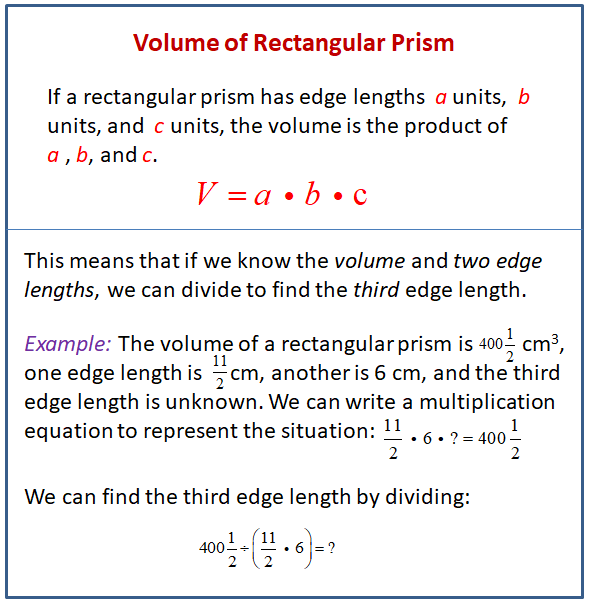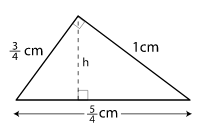Illustrative Mathematics Unit 6.4, Lesson 15: Volume of Prisms
Learning Targets:
- I can solve volume problems that involve fractions.
Related Pages
Illustrative Math
Grade 6
Lesson 15: Volume of Prisms
Let’s look at the volume of prisms that have fractional measurements.
Illustrative Math Unit 6.4, Lesson 15 (printable worksheets)
Lesson 15 Summary
The following diagram shows how to use division and multiplication to solve find the volumes of rectangular prisms with fractional bases and heights.

Lesson 15.1 A Box of Cubes
- How many cubes with an edge length of 1 inch fill this box?
- If the cubes had an edge length of 2 inches, would more or fewer cubes be needed to fill the box? Explain how you know.
- If the cubes had an edge length of ½ inch, would more or fewer cubes be needed to fill the box? Explain how you know.
Scroll down the page for the answer to the “Are you ready for more?” section.
Lesson 15.2 Cubes with Fractional Edge Lengths
- Diego correctly points out that 108 cubes with an edge length of ½ inch are needed to fill a rectangular prism that is 3 inches by 1 inch by 1⅓ inch. Explain or show how this is true. Draw a sketch, if needed.
- What is the volume, in cubic inches, of the rectangular prism? Show your reasoning.
- Lin and Noah are packing small cubes into a cube with an edge length of 1½ inches. Lin is using cubes with an edge length of ½ inch, and Noah is using cubes with an edge length of ¼ inch.
a. Who would need more cubes to fill the -inch cube? Show how you know.
b. If Lin and Noah use their small cubes to find the volume of the -inch cube, would they get the same value? Explain or show your reasoning.
Lesson 15.3 Fish Tank and Baking Pan
- A fish tank in a nature center has the shape of a rectangular prism. The tank is 10 feet long, 8¼ feet wide, and 6 feet tall.
a. What is the volume of the tank in cubic feet? Explain or show your reasoning.
b. The caretaker of the center filled ⅘ of the tank with water. What was the volume of the water in the tank in cubic feet? What was the height of the water in the tank? Explain or show your reasoning.
c. One day, the tank was filled with 330 cubic feet of water. The height of the water was what fraction of the height of the tank? Show your reasoning. - Clare’s recipe for banana bread won’t fit in her favorite pan. The pan is 8½ inches by 11 inches by 2 inches. The batter fills the pan to the very top, and when baking, the batter spills over the sides. To avoid spills, there should be about an inch between the top of the batter and the rim of the pan. Clare has another pan that is 9 inches by 9 inches by 2½ inches. If she uses this pan, will the batter spill over during baking?
Are you ready for more?
- Find the area of a rectangle with side lengths ½ and ⅔.
-
Show Answer
1/2 · 2/3 = 1/3
-
Show Answer
- Find the volume of a rectangular prism with side lengths ½, ⅔, and ¾.
-
Show Answer
1/2 · 2/3 · 3/4 = 1/4
-
Show Answer
- What do you think happens if we keep multiplying fractions ½ · ⅔ · ¾ · ⅘ · ⅚ …?
-
Show Answer
Since we are progressively multiplying by a fraction that is less than 1, the value will get smaller each time and will get closer and closer to 0.
-
Show Answer
- Find the area of a rectangle with side lengths 1/1 and 2/1.
-
Show Answer
1/1 · 2/1 = 2
-
Show Answer
- Find the volume of a rectangular prism with side lengths 1/1, 2/1, and 1/3.
-
Show Answer
1/1 · 2/1 · 1/3 = 2/3
-
Show Answer
- What do you think happens if we keep multiplying fractions 1/1 · 2/1 · 1/3 · 4/1 · 1/5 …?
-
Show Answer
The value will get bigger or smaller each time depending on whether the next number to multiply is greater or less than 1.
-
Show Answer
Lesson 15 Practice Problems
- A pool in the shape of a rectangular prism is being filled with water. The length and width of the pool is 24 feet and 15 feet. If the height of the water in the pool is 1½ feet, what is the volume of the water in cubic feet?
- A rectangular prism measures 2⅖ inches by 3⅕ inches by 2 inches.
a. Priya said, “It takes more cubes with edge length ⅖ inch than cubes with edge length ⅕ inch to pack the prism.” Do you agree with Priya’s statement? Explain or show your reasoning.
a. How many cubes with edge length ⅕ inch fit in the prism? Show your reasoning.
b. Explain how you can use your answer in the previous question to find the volume of the prism in cubic inches. - a. Here is a right triangle. What is its area?
b. What is the height h for the base that is 5/4 units long? Show your reasoning.
- To give their animals essential minerals and nutrients, farmers and ranchers often have a block of salt—called “salt lick”—available for their animals to lick.
a. A rancher is ordering a box of cube-shaped salt licks. The edge lengths of each salt lick are 5/12 foot. Is the volume of one salt lick greater or less than 1 cubic foot? Explain your reasoning.
b. The box that contains the salt lick is 1¼ feet by 1⅔ feet by ⅚ feet. How many cubes of salt lick fit in the box? Explain or show your reasoning. - a. How many groups of ⅓ inch are in ¾ inch?
b. How many inches are in 1⅖ groups of 1&farc23; inches? - Here is a table that shows the ratio of flour to water in an art paste. Complete the table with values in equivalent ratios.
| cups of flour | cups of water |
| 1 | ½ |
| 4 | |
| 3 | |
| ½ |
The Open Up Resources math curriculum is free to download from the Open Up Resources website and is also available from Illustrative Mathematics.
Try out our new and fun Fraction Concoction Game.
Add and subtract fractions to make exciting fraction concoctions following a recipe. There are four levels of difficulty: Easy, medium, hard and insane. Practice the basics of fraction addition and subtraction or challenge yourself with the insane level.

We welcome your feedback, comments and questions about this site or page. Please submit your feedback or enquiries via our Feedback page.

